Sensitivity of Axial Velocity at the Air Gap Entrance to Flow Rate Distribution at Stator Radial Ventilation Ducts of Air-Cooled Turbo-Generator with Single-Channel Ventilation
Abstract
:1. Introduction
2. Experimental Measurement and Result Analysis
2.1. Test and Measurement of the Velocities at Air Gap Inlet and Radial Ventilation Duct Outlets in the Generator
2.2. Stator Radial Ventilation Duct Outlet Flow Rate Measurement Results
3. Study on Sensitivity of Air Gap Inlet Flow Velocity to Stator Radial Ventilation Duct Flow Rate Distribution
3.1. Mathematical Model and Physical Model Description
3.1.1. Mathematical Model Description
3.1.2. Physical Model Description, Mesh Analysis, and the Boundary Conditions
- (1)
- The air gap inlet is set as the velocity boundary condition, which is given according to the measurement results: The angle between the measuring element direction (Figure 3) and the axial direction is about 40 degrees, and the measured velocity is 74 m/s. Therefore, after triangle calculation, the inlet velocity of the air gap entrance is given as 56 m/s.
- (2)
- The 38 radial ventilation outlets (half of generator) are basically balanced with the surrounding atmospheric pressure. Given the pressure boundary condition, the value is equivalent to one atmospheric pressure.
- (3)
- The air gap exists in the whole circumferential direction, but the calculation model includes two additional surfaces, S1, S2 (shown in Figure 7), at the air gap that will increase the frictional resistance when fluid flows. In fact, this frictional resistance does not exist, so the periodic boundary conditions given for these two sides, eliminate the influence of frictional resistance on fluid flow.
- (4)
- The velocity inlet of the rotor is given as the velocity boundary condition, and the velocity value is given according to the calculation results of the rotor ventilation calculation.
3.2. Comparison of Fluid Calculation Results and Measured Values at Test Conditions
3.3. Study on Sensitivity of Axial Velocity at the Air Gap Entrance to Flow Rate Distribution at Stator Radial Ventilation Ducts
3.4. The Influence of Backflow in the Radial Ventilation Duct on the Temperature of the Stator Winding and Core
4. Conclusions
- Through the measurement of the fluid flow law in the stator radial ventilation duct, it is found that after the fluid passes through the first three radial ventilation ducts, the wind speed will decrease significantly in the back one or two radial ventilation ducts.
- Through calculation and research, it is found that with the increase of the flow velocity at the air gap entrance, the flow velocity in several radial ventilation ducts after the step structure of the stator core end will gradually decrease to zero. At this time, if flow velocity at the air gap inlet continues to increase, the velocity direction of fluid in radial ventilation ducts will reverse, forming a backflow.
- The backflow of the fluid in the ventilation duct will have a direct impact on the temperature rise of the local stator core, which is likely to produce local overheating of the core and affect the safe operation of the unit.
Author Contributions
Funding
Conflicts of Interest
References
- Pickering, S.J.; Lampard, D.; Shanel, M. Modelling Ventilation and Cooling of The Rotors of Salient Pole Machines. In Proceedings of the IEEE International Electric Machines and Drives Conference (IEMDC), Cambridge, MA, USA, 17–20 June 2001; pp. 806–808. [Google Scholar] [CrossRef]
- Shanel, M.; Pickering, S.J.; Lampard, D. Conjugate Heat Transfer Analysis of a Salient Pole Rotor in an Air-Cooled Synchronous Generator. In Proceedings of the International Electric Machines and Drives Conference, Madison, WI, USA, 1–4 June 2003; Volume 2, pp. 737–741. [Google Scholar] [CrossRef]
- Shoulu, G.; Yichao, Y.; Yuzheng, L. Review on ventilation system of large turbine generator. Energy Res. Inf. 2004, 4, 195–200. [Google Scholar]
- Shuang, L.; Zhihua, A.; Guangyu, Q. Research and performance verification of 150 MW air-cooled turbo-generator ventilation system. Large Mot. Technol. 2007, 1, 8–10. [Google Scholar]
- Dongping, Z.; Rongshan, C. Calculation of ventilation and temperature rise of 100–200 MW air-cooled turbo-generator. Power Gener. Equip. 2006, 3, 193–195. [Google Scholar]
- Guangde, L.; Weihong, Z. Ventilation system design of air-cooled turbo-generator. Large Mot. Technol. 1998, 4, 13–16. [Google Scholar]
- Yamamoto, M.; Kimura, M. Ventilation and cooling technology of a new series of double-pole air-cooled steam turbine generator (Translated by Cai Qianhua). Foreign Large Electr. Mot. 2000, 3, 16–18. [Google Scholar]
- Chauveau, E.; Zaim, E.H.; Trichet, D.; Fouladgar, J. A statistical of temperature calculation in electrical machines. IEEE Trans. Mag. 2000, 36, 1826–1829. [Google Scholar] [CrossRef]
- Fujita, M.; Kabata, Y.; Tokumasu, T.; Kakiuchi, M.; Shiomi, H.; Nagano, S. Air-Cooled Large Turbine Generator with Multiple-Pitched Ventilation Ducts. In Proceedings of the IEEE International Conference on Electric Machines and Drives, San Antonio, TX, USA, 15 May 2005; pp. 910–917. [Google Scholar] [CrossRef]
- Zixiong, Z.; Zengnan, D. Viscous Fluid Mechanics; Tsinghua University Press: Beijing, China, 1998; pp. 255–279. [Google Scholar]
- Borishenko, A.N. Aerodynamics and Heat Transfer in Motor; Machinery Industry Press: Beijing, China, 1985. [Google Scholar]
- Changming, Y. Heat Conduction and Its Numerical Analysis; Tsinghua University Press: Beijing, China, 1981; pp. 1–7. [Google Scholar]
- Huo, F.; Li, Y.; Li, W. Calculation and analysis of stator ventilation structure optimization scheme of large air-cooled turbo-generator. Chin. J. Electr. Eng. 2010, 6, 95–103. [Google Scholar]
- Li, H.J.W. Calculation and analysis of fluid velocity and fluid temperature in large air-cooled turbo-generator stator. Proc. CSEE 2006, 26, 168–173. [Google Scholar] [CrossRef]
- Li, W.; Ding, S.; Zhou, F. Diagnostic numerical simulation of large hydro-generator with insulation aging. Heat Transf. Eng. 2008, 29, 902–909. [Google Scholar] [CrossRef]
- Li, W.; Hou, Y. Heating analysis of stator strands of large hydro-generator based on numerical method. Proc. CSEE 2001, 21, 115–1186. [Google Scholar] [CrossRef]
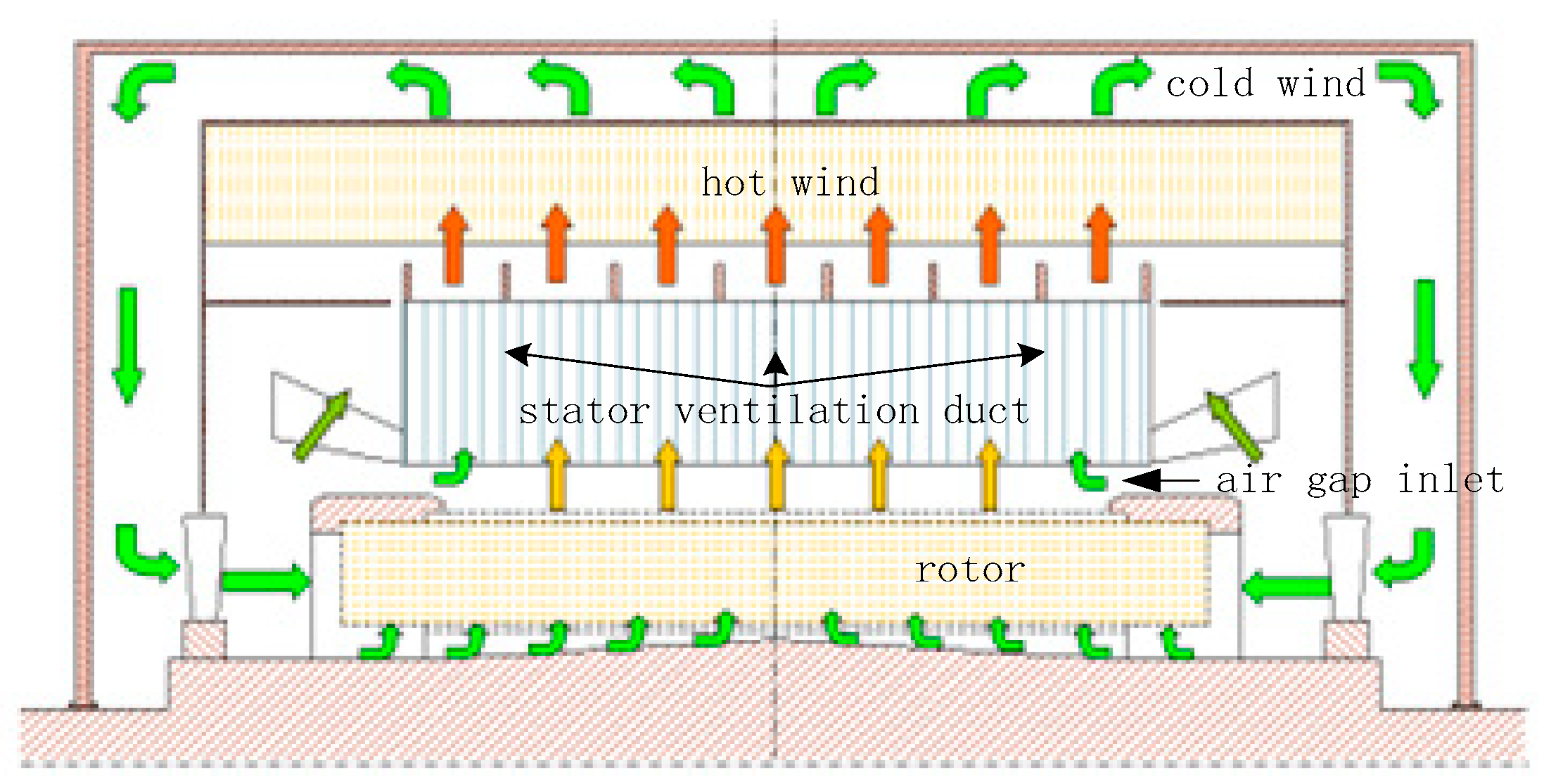
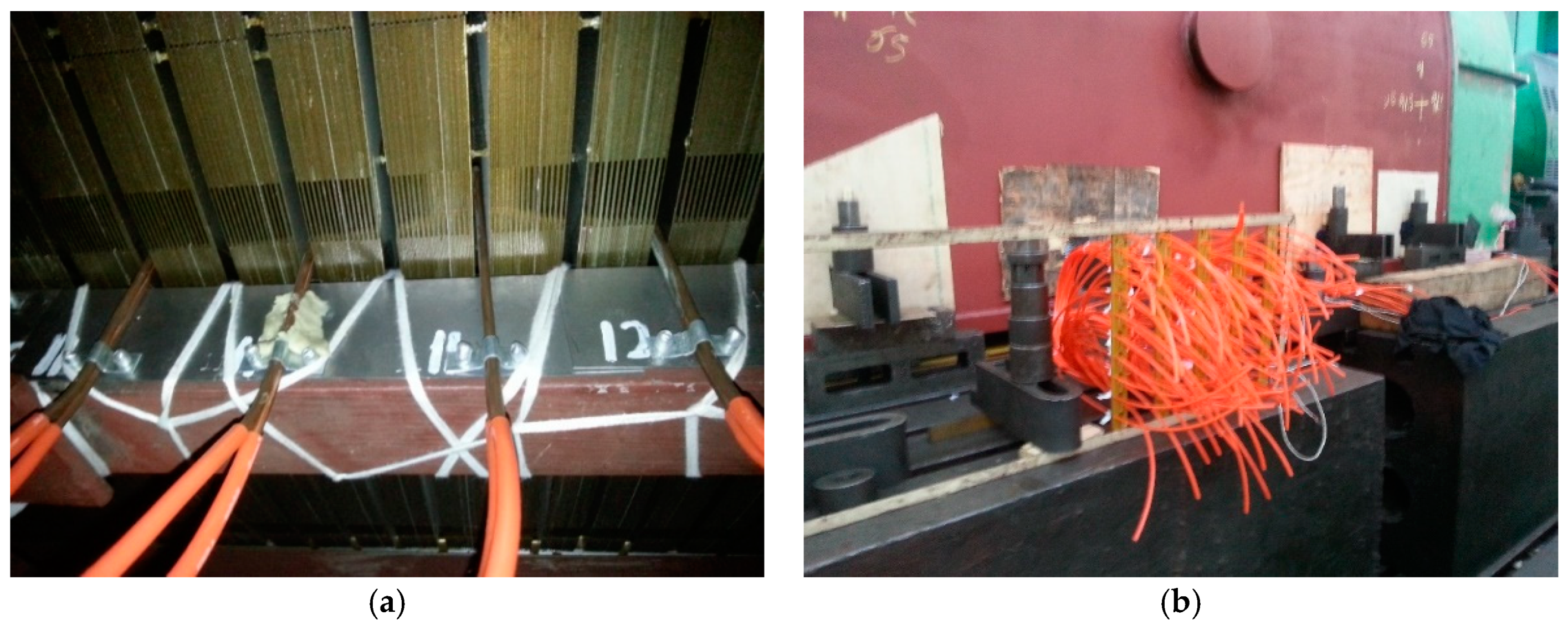

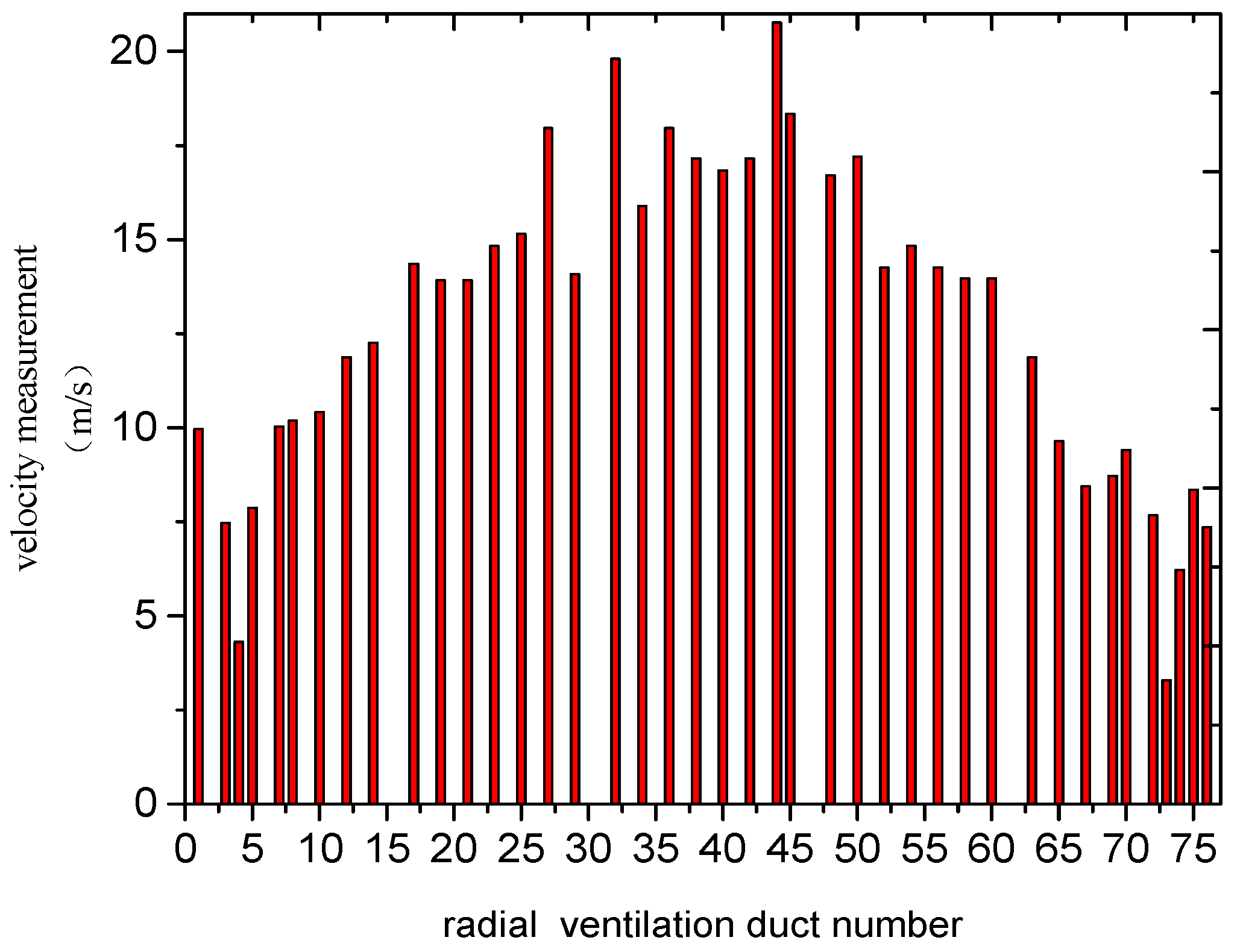

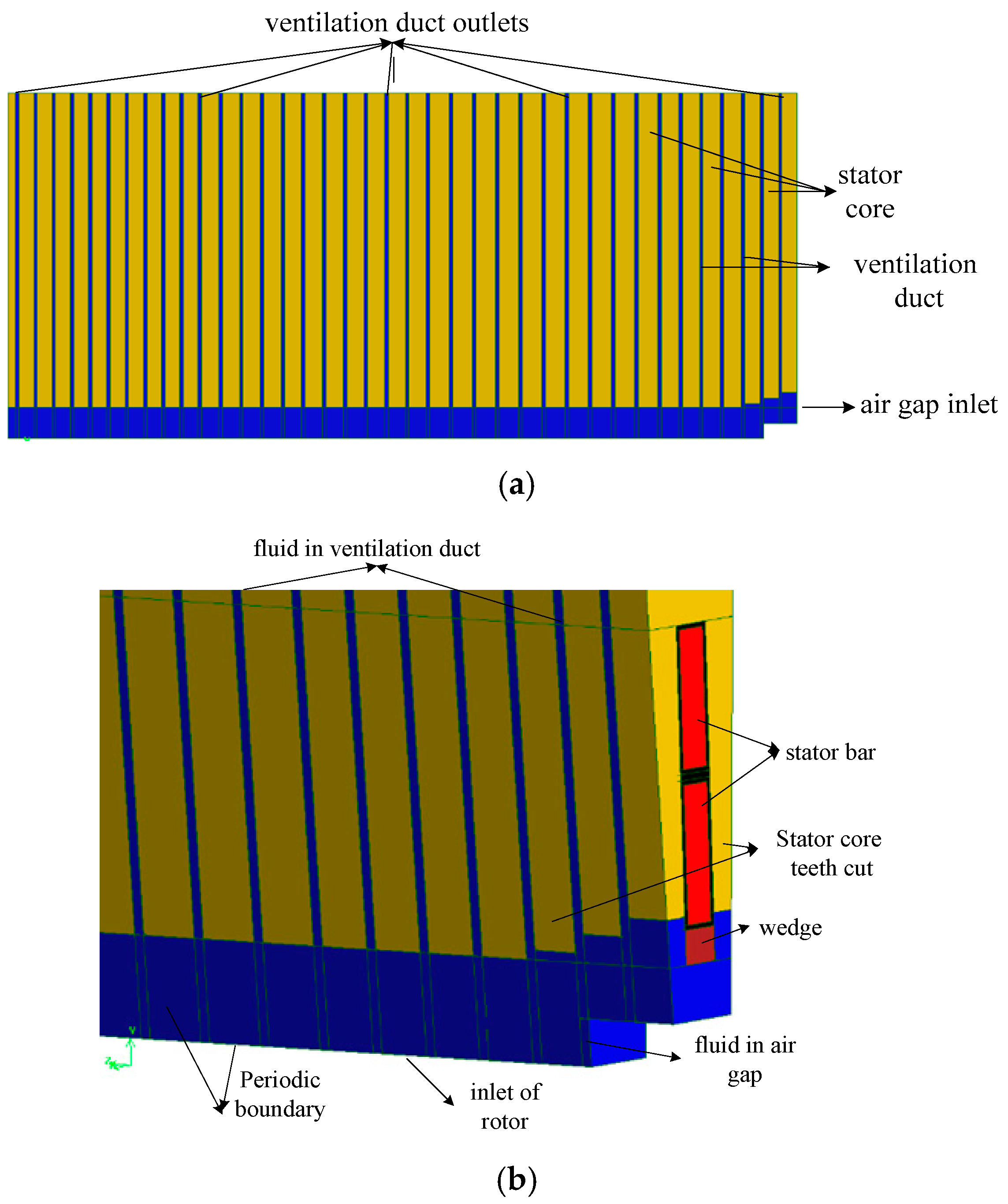
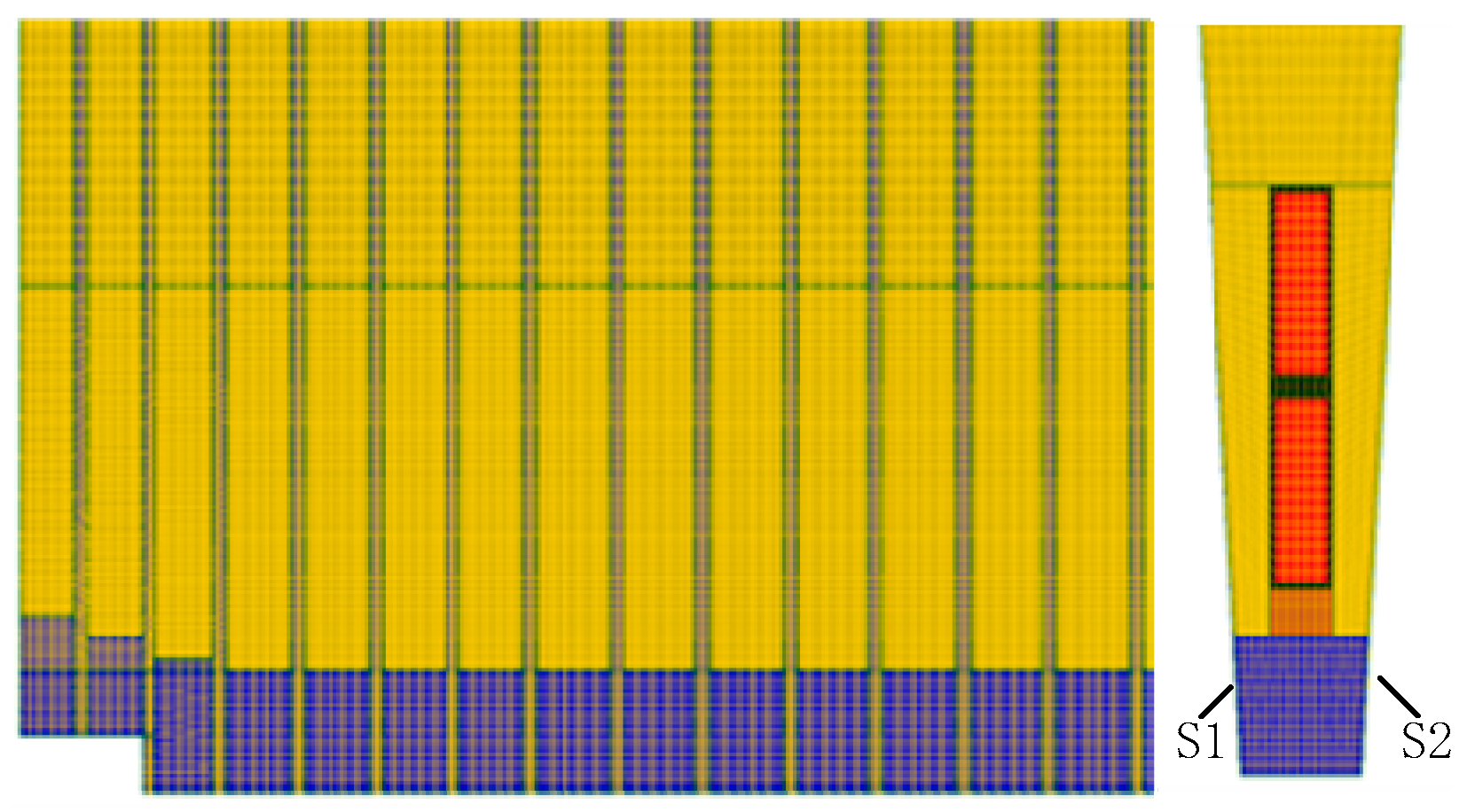
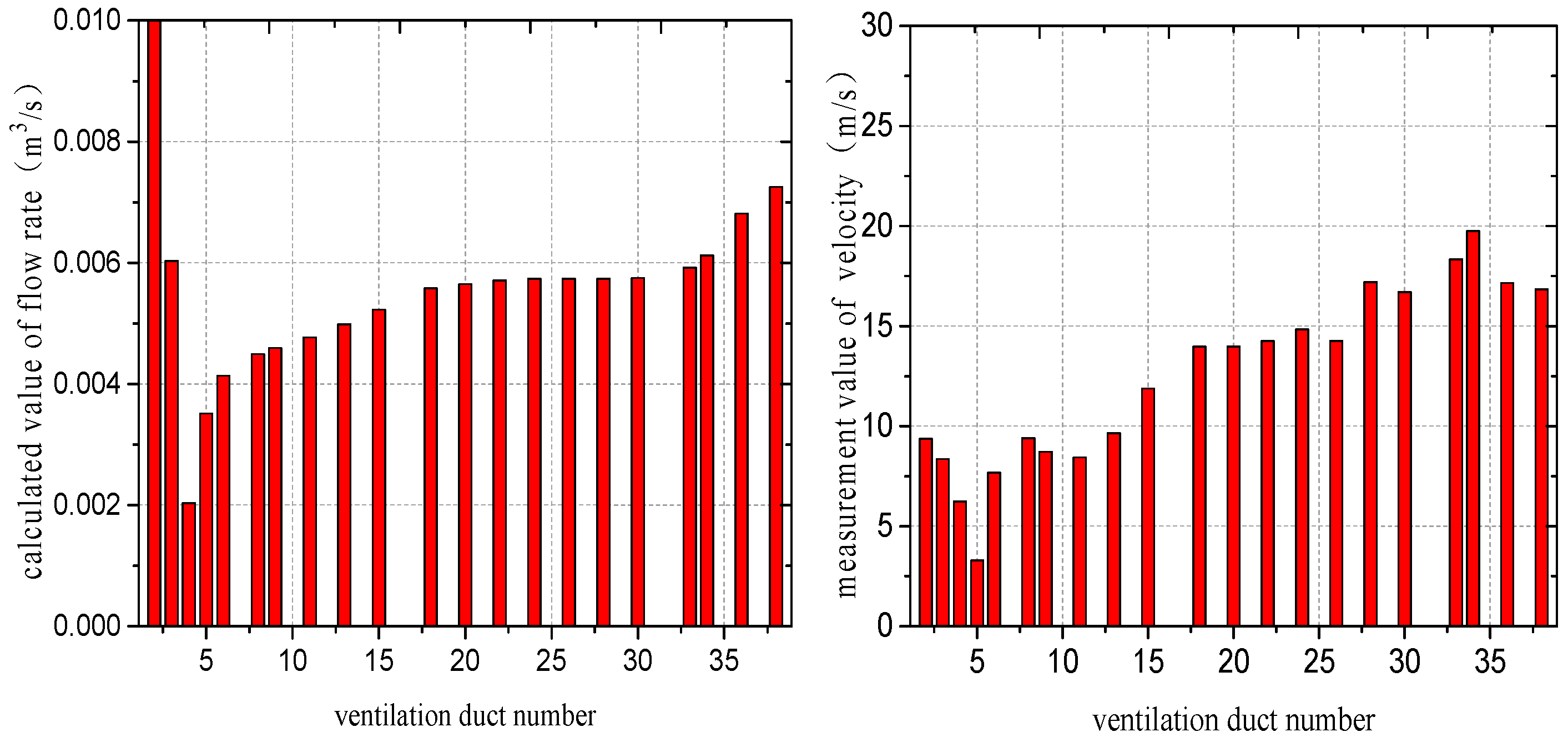
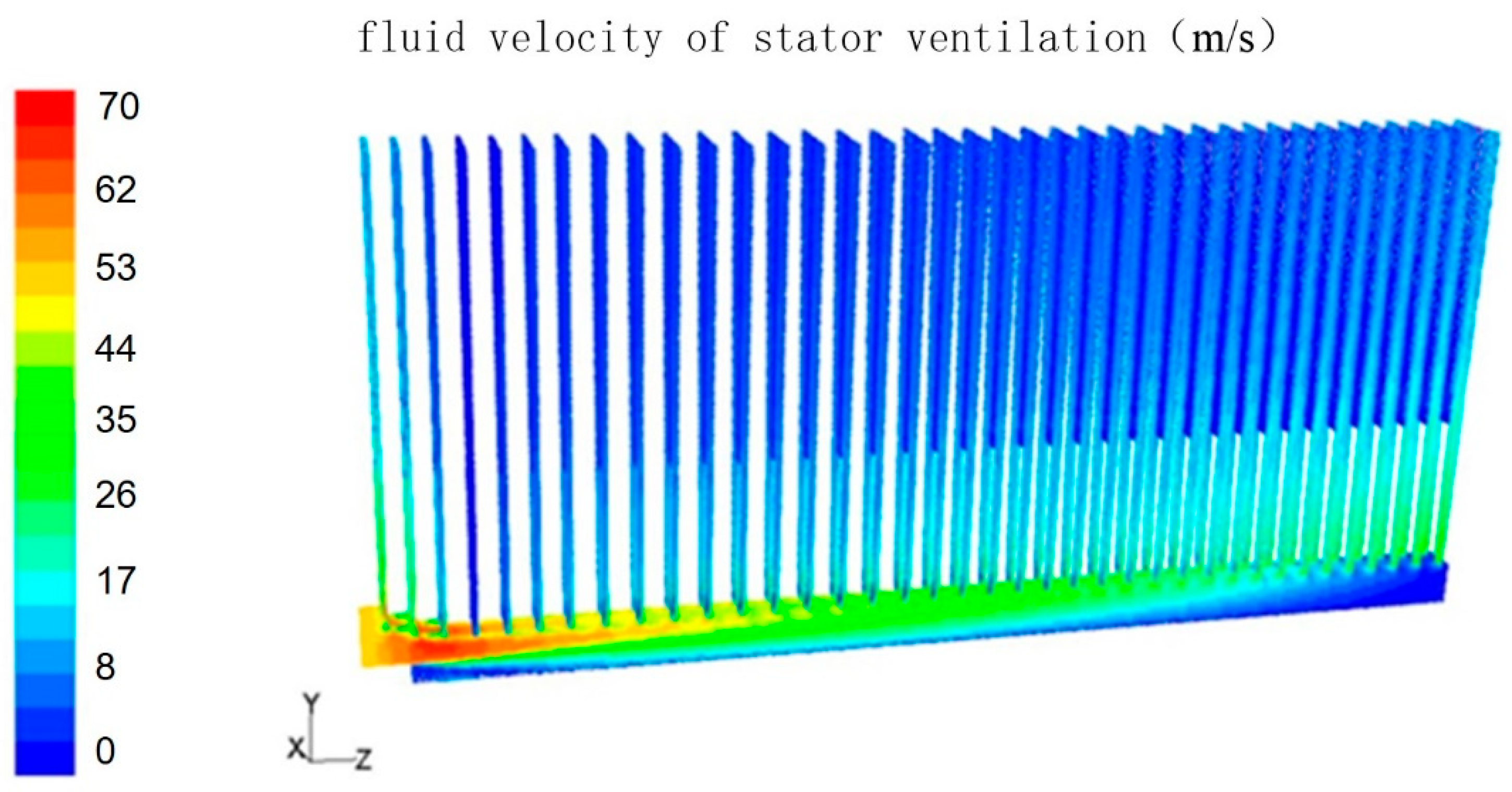

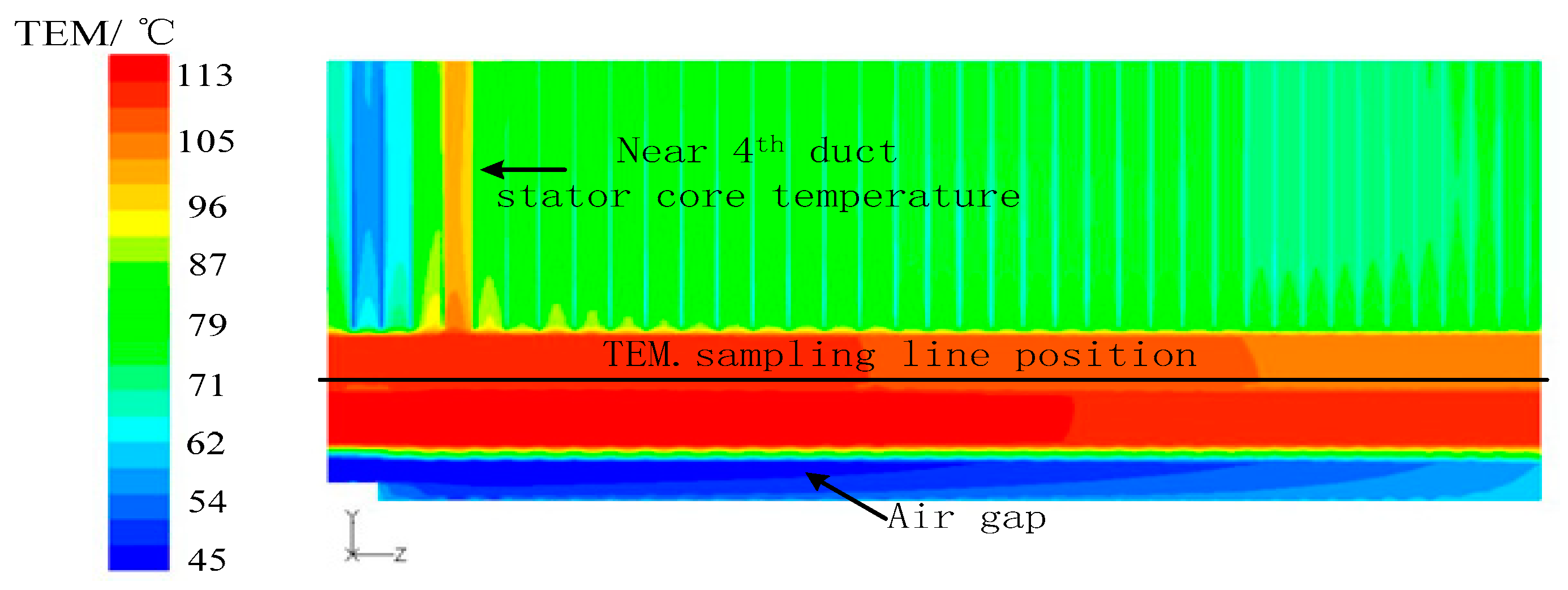

| No. of Ventilation Ducts | Total Pressure Pa | Static Pressure Pa | Pressure Difference Pa | Calculated Wind Speed m/s |
|---|---|---|---|---|
| 2 | 1514 | 1464 | 50 | 8.8 |
| 3 | 1324 | 1256 | 68 | 10.3 |
| 4 | 1188 | 1178 | 10 | 3.9 |
| 5 | 1122 | 1117 | 5 | 2.8 |
| 6 | 1153 | 1143 | 10 | 3.9 |
| 8 | 1205 | 1145 | 60 | 9.6 |
| 9 | 1178 | 1125 | 53 | 9.1 |
| 11 | 1173 | 1136 | 37 | 7.6 |
| 13 | 1193 | 1144 | 49 | 8.7 |
| 15 | 1238 | 1153 | 85 | 11.5 |
| 18 | 1231 | 1118 | 113 | 13.2 |
| 20 | 1191 | 1088 | 103 | 12.6 |
| 22 | 1201 | 1085 | 116 | 13.4 |
| 24 | 1231 | 1092 | 139 | 14.7 |
| 26 | 1211 | 1097 | 114 | 13.3 |
| 28 | 1270 | 1103 | 167 | 16.1 |
| 30 | 1257 | 1089 | 168 | 16.1 |
| 33 | 1317 | 1117 | 200 | 17.6 |
| 34 | 1367 | 1097 | 270 | 20.5 |
| 36 | 1286 | 1094 | 192 | 17.3 |
| 38 | 1259 | 1112 | 147 | 15.1 |
| 40 | 1359 | 1103 | 256 | 19.9 |
| 42 | 1304 | 1093 | 211 | 18.1 |
| 44 | 1263 | 1094 | 169 | 16.2 |
| 46 | 1353 | 1108 | 245 | 19.5 |
| 49 | 1142 | 1281 | −139 | 14.7 |
| 51 | 1359 | 1152 | 207 | 17.9 |
| 53 | 1289 | 1144 | 145 | 15.0 |
| 55 | 1281 | 1134 | 147 | 15.1 |
| 57 | 1259 | 1140 | 119 | 13.6 |
| 59 | 1260 | 1124 | 136 | 14.5 |
| 61 | 1311 | 1162 | 149 | 15.2 |
| 64 | 1298 | 1206 | 92 | 11.9 |
| 66 | 1284 | 1209 | 75 | 10.8 |
| 68 | 1280 | 1216 | 64 | 10.0 |
| 70 | 1256 | 1203 | 53 | 9.1 |
| 71 | 1256 | 1212 | 44 | 8.3 |
| 73 | 1205 | 1191 | 14 | 4.7 |
| 74 | 1019 | 1172 | −153 | 15.4 |
| 75 | 1259 | 1220 | 39 | 7.8 |
| 76 | 1576 | 1515 | 61 | 9.7 |
| Cells | Faces | Nodes | Edges | |
|---|---|---|---|---|
| Number Used | 561,180 | 1,830,765 | 692,014 | 0 |
| Mbytes Used | 102 | 136 | 29 | 0 |
| Number Allocated | 561,180 | 1,830,765 | 692,014 | 0 |
© 2019 by the authors. Licensee MDPI, Basel, Switzerland. This article is an open access article distributed under the terms and conditions of the Creative Commons Attribution (CC BY) license (http://creativecommons.org/licenses/by/4.0/).
Share and Cite
Li, Y.; Li, W.; Su, Y. Sensitivity of Axial Velocity at the Air Gap Entrance to Flow Rate Distribution at Stator Radial Ventilation Ducts of Air-Cooled Turbo-Generator with Single-Channel Ventilation. Energies 2019, 12, 3442. https://doi.org/10.3390/en12183442
Li Y, Li W, Su Y. Sensitivity of Axial Velocity at the Air Gap Entrance to Flow Rate Distribution at Stator Radial Ventilation Ducts of Air-Cooled Turbo-Generator with Single-Channel Ventilation. Energies. 2019; 12(18):3442. https://doi.org/10.3390/en12183442
Chicago/Turabian StyleLi, Yong, Weili Li, and Ying Su. 2019. "Sensitivity of Axial Velocity at the Air Gap Entrance to Flow Rate Distribution at Stator Radial Ventilation Ducts of Air-Cooled Turbo-Generator with Single-Channel Ventilation" Energies 12, no. 18: 3442. https://doi.org/10.3390/en12183442
APA StyleLi, Y., Li, W., & Su, Y. (2019). Sensitivity of Axial Velocity at the Air Gap Entrance to Flow Rate Distribution at Stator Radial Ventilation Ducts of Air-Cooled Turbo-Generator with Single-Channel Ventilation. Energies, 12(18), 3442. https://doi.org/10.3390/en12183442





